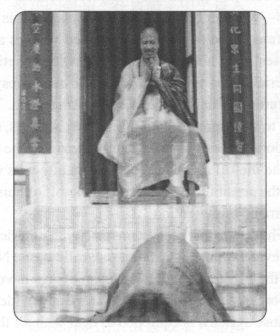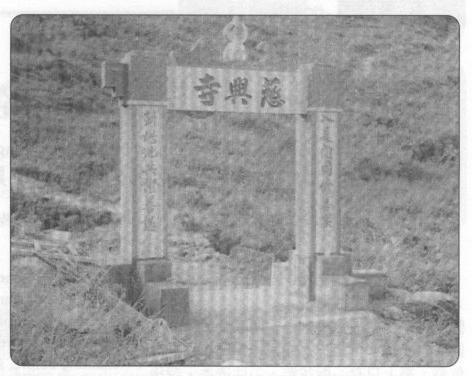
後來上人另謀他法,在香港仔上船(當時並沒有天星小輪,也沒有青馬大橋),搭漁船到大澳碼頭,從大澳碼頭開始三步一拜,拜上慈興寺。若在平日從大澳碼頭步行到慈興寺,也要兩、三個小時才到。這一切的一切,全是為了早日把慈興寺興建完成。
慈興寺修建時已是殘破不堪,牆上彈痕累累,地上很多骸骨。原因是二次世界大戰時游擊隊把慈興寺用作基地,日本人由大澳碼頭打上慈興寺與游擊隊開戰,殺了很多人,所以留下很多骸骨。戰後也沒有人清理,上人用了甚多時問起度陣亡的死難者。慈興寺的鬼多是出了名的,住在寺的人經常見鬼,這些鬼多到把自己逼得都快沒路可走了,也常跟常住開玩笑。怎樣開玩笑呢?例如以前用火水爐或煤炭煮飯,當生火時,火柴會無緣無故地被吹熄,但又四下無人,往往一餐飯要費很久時間。上人在慈興寺時,常向一個方向持咒,若見上人不發一言時,便知正在超度他們。
有趣的是,雖然這麼多的鬼,但上人對尚是居士身的恆益說:「鬼見到你個個都給嚇跑了。」有次慈興寺打佛七,也傳幽冥戒,上人要恆益師寫牌位,恆益師說:「我家人都沒有死,寫什麼牌位?」可是這段時間她總是無緣無故跌倒,走路也跌倒,上樓梯也跌倒。上人說妳的身後有一個身材高大的鬼跟著,但恆益師始終不知是誰。佛七打了三天,經上人加持後,才知道原來有一個同姓的兄弟來港,因染大熱症去世。
從1949年起,用了三年時間修築兩部份,先是西方三聖,屬於女眾道場,在風水上是一塊佛地。等西方三聖開光後,再在右邊建大雄寶殿(男眾道場),它的前身是國清寺,1951年完工後改名為慈興禪寺,是專供修行的好地方。恆興師說:「不是真心的修行人在慈興寺是住不下去的,曾有一位叫本地羅漢的人住了一夜就走。」
初期沒有人供養,恆益師只好開田墾荒,自己耕種,開始時只有恆益師和一位老人家,以後陸續有九個人來幫忙:三個做廚房,四個種田,兩個打掃。
慈興寺開光後,便開始打觀音七、佛七,每次打七都有百多個人來參加,晚上講經到十點。聽經的人都是四、五十歲以上的居士,他們要走數百級的階梯才能到山上。慈興寺每年至少要打十個禪七,多則二十個,當時有很多從大陸逃難來的法師在此修行。
待續

|
|
The Master had another plan. After taking a fishing boat from Aberdeen (neither the Star Ferry nor the Green Horse Bridge existed then) to the Taio Pier, he made a bowing pilgrimage to Cixing Monastery, making a full prostration every three steps of the way. Normally, it took two or three hours to walk from Taio Pier to the monastery. The Master bowed with the wish that Cixing Monastery would soon be completed.
The buildings that were renovated to become Cixing Monastery were incredibly dilapidated. The walls were gutted with bullet holes; the ground was strewn with bones. The place had been used as a base camp by guerrilla troops during the Second World War. Large numbers of people were killed in the battle that ensued when Japanese troops landed at the Taio Pier and reached the site of Cixing Monastery, covering the ground with bones. The place had not been cleaned at all after the war. The Master spent much time praying for, and rescuing those who had died in battle. Cixing Monastery is known for being inhabited by ghosts. Residents of the monastery see ghosts all the time. There are so many of them around that people can barely walk. The ghosts like to play practical jokes on the residents. For example, when someone uses the kerosene stove or charcoal to start a fire for cooking, the match is often mysteriously snuffed, when no one else is around. Thus meals often take a long time to prepare. When the Master was at Cixing Monastery, he often recited mantras in a certain direction. When people saw the Master not saying a word, they knew he was liberating ghosts.
There were numerous ghosts, but interestingly enough, the Master told Heng Yi (at that time still a layperson), "Ghosts are scared away as soon as they see you." Once during a Buddha recitation session, the Precepts for the Deceased were going to be transmitted and the Master asked Heng Yi Shi to write a plaque. Heng Yi Shi said, "There hasn't been any death in my family. Why should I write a plaque?" During that period, whether walking or going up the stairs, Heng Yi Shi regularly stumbled and fell. The Master told her that a very tall, large ghost was following her, but she didn't know who it was. On the third day of the session, through the Master's aid, she discovered that a relative of hers had gone to Hong Kong and died of fever.

The construction began in 1949 and was completed in two stages over three years. First, a hall for the Three Sages of the West (the women's hall) was built on the west side. It had excellent geomancy. After that hall had its opening ceremony, the Jeweled Hall of Great Heroes (the men's Way-place) was built to its right, where the former Guoqing Monastery had been. When that hall, a fine place for cultivation, was completed in 1951, it was renamed Cixing Chan Monastery. Heng Sying Shr comments, "Those who are not sincere about cultivation are unable to remain long. Once, someone known as the local Arhat left after staying only one night."
Since no one made offerings in the beginning, Heng Yi Shr had to farm the land herself. She and an elderly person did it alone at first. Later there were nine helpers: three worked in the kitchen, three planted the fields, and two did cleaning. After the opening ceremony was held Cixing Monastery began to hold Guanyin Sessions and Buddha Recitation Sessions. Over a hundred people participated in each session. There were Sutra lectures till ten o'clock every evening, attended by laypeople in their forties and fifties who would walk up over a hundred steps to reach the monastery. Cixing Monastery held ten to twenty weeks of Chan sessions each year. Many Dharma Masters who had fled the Mainland cultivated there.
To be continued |